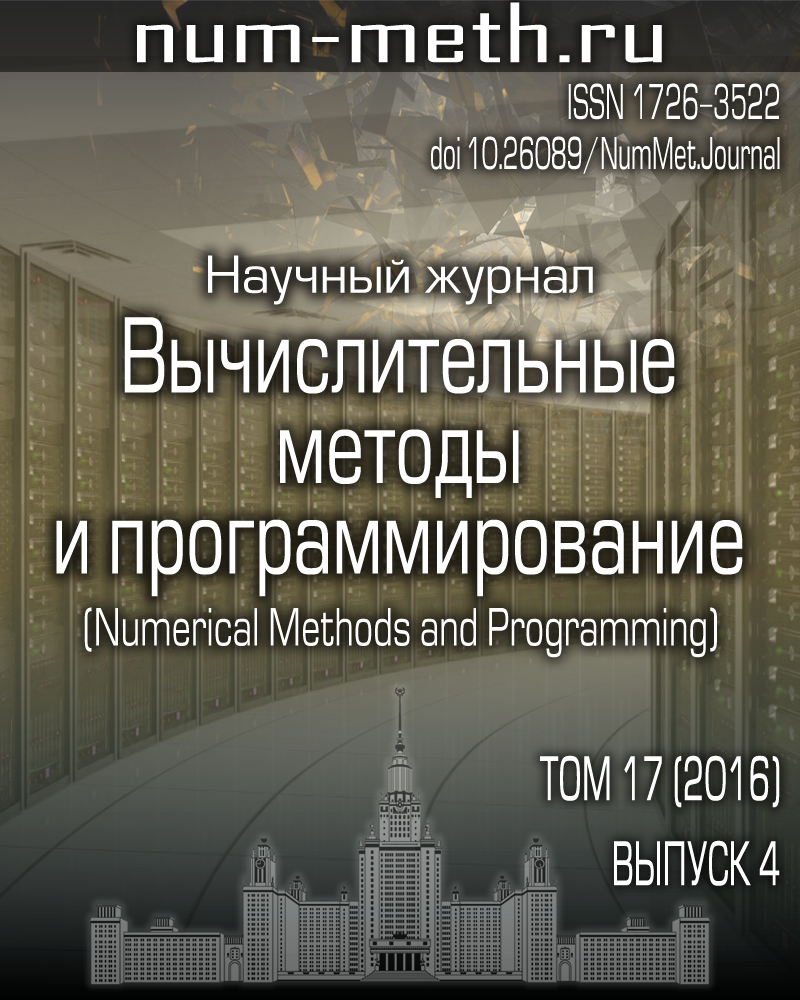DOI: https://doi.org/10.26089/NumMet.v17r438
Об одной задаче синтеза бинарных нанооптических элементов
Ключевые слова:
Аннотация
В рамках широко распространенной технологии Augmented Reality обсуждается возможность контроля подлинности защитных оптических меток на основе бинарных нанооптических элементов. С помощью смартфона фотографируют изображение защитной метки. Полученное изображение интерпретируется как дифракционный оптический элемент. В приближении Френеля рассчитывают изображение, формируемое дифракционным оптическим элементом, которое используют для идентификации подлинности защитной метки. Защитная метка представляет собой фазовый оптический элемент, глубина микрорельефа которого не превышает 0.5 мкм. Нанооптические элементы изготавливаются с помощью электроннолучевой литографии. Разработанные нанооптические элементы устойчивы к частичному повреждению микрорельефа и могут быть использованы для идентификации банкнот, документов и др.
Загрузки
Опубликован
Выпуск
Раздел
Библиографические ссылки
- An. Firsov, A. Firsov, B. Loechel, et al., “Fabrication of Digital Rainbow Holograms and 3-D Imaging Using SEM Based E-Beam Lithography.’’ Opt. Express. 22 (23), 28756-28770 (2014).
- Y. Sheng and J. Wang, “Binary Hologram of Very Large Space Bandwidth Product Designed by the Genetic Algorithm,” Digital Holography & 3-D Imaging Meeting, OSA Technical Digest (2015).
doi 10.1364/DH.2015.DM4A.3 - P. Rai-Choudhury (Ed.), Handbook of Microlithography, Micromachining, and Microfabrication , Vol. 1: Microlithography (SPIE Press, Bellingham, 1997).
- R. L. van Renesse, Optical Document Security (Artech House, Boston, 1998).
- A. Goncharsky, A. Goncharsky, and S. Durlevich, “Diffractive Optical Element for Creating Visual 3D Images,” Opt. Express 24 (9). 9140-9148 (2016).
- A. Goncharsky, A. Goncharsky, and S. Durlevich, “Diffractive Optical Element with Asymmetric Microrelief for Creating Visual Security Features,” Opt. Express 23 (22). 29184-29192 (2015).
- A. A. Goncharsky and S. R. Durlevich, “A Problem of Synthesis of Nano-Optical Elements for the Formation of Dynamic Images,” Vychisl. Metody Programm. 14, 343-347 (2013).
- A. A. Goncharsky, “On the Problem of Synthesis of Nano-Optical Elements,” Vychisl. Metody Programm. 9, 405-408 (2008).
- M. Aleksy, E. Vartiainen, V. Domova, and M. Naedele, “Augmented Reality for Improved Service Delivery,” in Proc. IEEE 28th Int. Conf. on Advanced Information Networking and Applications, Victoria, Canada, May 13-16, 2014 (IEEE Press, Washington, DC, 2014), pp. 382-389.
- F. Belloni and S. Monneret, “Quadrant Kinoform: An Approach to Multiplane Dynamic Three-Dimensional Holographic Trapping,” Appl. Opt. 46 (21), 4587-4593 (2007).
- P. Karvinen, D. Grolimund, M. Willimann, et al., “Kinoform Diffractive Lenses for Efficient Nano-Focusing of Hard X-Rays,” Opt. Express 22 (14), 16676-16685 (2014).
- H. Zhang, H. Liu, Z. Lu, and H. Zhang, “Modified Phase Function Model for Kinoform Lenses,” Appl. Opt. 47 (22), 4055-4060 (2008).
- T. R. M. Sales and G. M. Morris, “Diffractive-Refractive Behavior of Kinoform Lenses,” Appl. Opt. 36 (1), 253-257 (1997).
- K. J. Moh, X.-C. Yuan, W. C. Cheong, et al., “High-Power Efficient Multiple Optical Vortices in a Single Beam Generated by a Kinoform-Type Spiral Phase Plate,” Appl. Opt. 45 (6), 1153-1161 (2006).
- X.-C. Yuan, B. P. S. Ahluwalia, W. C. Cheong, et al., “Direct Electron Beam Writing of Kinoform Micro-Axicon for Generation of Propagation-Invariant Beams with Long Non-Diffracting Distance,” J. Opt. A: Pure Appl. Opt. 9, 329-334 (2007).
- L. B. Lesem, P. M. Hirsch, and J. A. Jordan, “The Kinoform: A New Wave-Front Reconstruction Device,” IBM J. Res. Dev. 13, 105-155 (1969).
- A. V. Goncharsky and A. A. Goncharsky, Computer Optics and Computer Holography (Mosk. Gos. Univ., Moscow, 2004) [in Russian].
- Q. Tan, Y. Yan, G. Jin, and D. Xu, “Fine Design of Diffractive Optical Element for Beam Transform,” Proc. SPIE 4443, 184-188 (2001).
doi 10.1117/12.446750 - J. R. Fienup, “Phase Retrieval Algorithms: A Comparison,” Appl. Opt. 21 (15), 2758-2769 (1982).
- F. Mohammad, J. Anarase, M. Shingote, and P. Ghanwat, “Optical Character Recognition Implementation Using Pattern Matching,” Int. J. Comput. Sci. Inform. Technol. 5 (2), 2088-2090 (2014).
- A. F. Mollah, N. Majumder, S. Basu, and M. Nasipuri, “Design of an Optical Character Recognition System for Camera-Based Handheld Devices,” Int. J. Comput. Sci. Iss. 8 (4), 283-289 (2011).
- D. G. Lowe, “Distinctive Image Features from Scale-Invariant Keypoints,” Int. J. Comput. Vis. 60 (2), 91-110 (2004).


